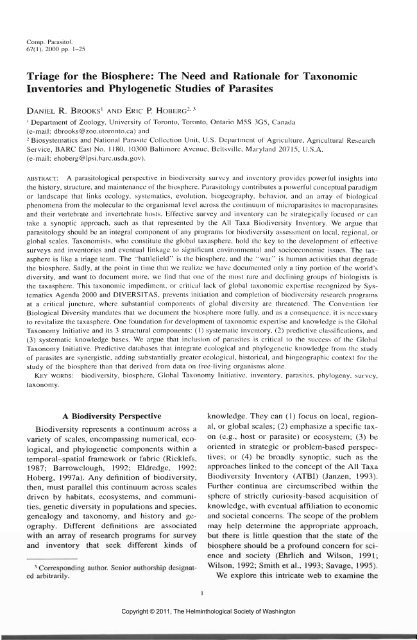Comparative Parasitology 67(1) 2000 - Peru State College
Comparative Parasitology 67(1) 2000 - Peru State College
Comparative Parasitology 67(1) 2000 - Peru State College
You also want an ePaper? Increase the reach of your titles
YUMPU automatically turns print PDFs into web optimized ePapers that Google loves.
Comp. Parasitol.<br />
<strong>67</strong>(1). <strong>2000</strong> pp. 1-25<br />
Triage for the Biosphere: The Need and Rationale for Taxoiiomic<br />
Inventories and Phylogeiietic Studies of Parasites<br />
DANIEL R. BROOKS' AND ERIC P. HoBERG2 ^<br />
1 Department of Zoology, University of Toronto, Toronto, Ontario M5S 3G5, Canada<br />
(e-mail: dbrooks@zoo.utoronto.ca) and<br />
2 Biosystematics and National Parasite Collection Unit, U.S. Department of Agriculture, Agricultural Research<br />
Service, BARC East No. 1 180, 10300 Baltimore Avenue, Beltsville, Maryland 20715, U.S.A.<br />
(e-mail: ehoberg@lpsi.barc.usda.gov).<br />
ABSTRACT: A parasitological perspective in biodiversity survey and inventory provides powerful insights into<br />
the history, structure, and maintenance of the biosphere. <strong>Parasitology</strong> contributes a powerful conceptual paradigm<br />
or landscape that links ecology, systematics, evolution, biogeography, behavior, and an array of biological<br />
phenomena from the molecular to the organismal level across the continuum of microparasites to macroparasites<br />
and their vertebrate and invertebrate hosts. Effective survey and inventory can be strategically focused or can<br />
take a synoptic approach, such as that represented by the All Taxa Biodiversity Inventory. We argue that<br />
parasitology should be an integral component of any programs for biodiversity assessment on local, regional, or<br />
global scales. Taxonomists, who constitute the global taxasphere, hold the key to the development of effective<br />
surveys and inventories and eventual linkage to significant environmental and socioeconomic issues. The taxasphere<br />
is like a triage team. The "battlefield" is the biosphere, and the "war" is human activities that degrade<br />
the biosphere. Sadly, at the point in time that we reali/,e we have documented only a tiny portion of the world's<br />
diversity, and want to document more, we find that one of the most rare and declining groups of biologists is<br />
the taxasphere. This taxonomic impediment, or critical lack of global taxonomic expertise recognized by Systematics<br />
Agenda <strong>2000</strong> and DIVERSITAS, prevents initiation and completion of biodiversity research programs<br />
at a critical juncture, where substantial components of global diversity are threatened. The Convention for<br />
Biological Diversity mandates that we document the biosphere more fully, and as a consequence, it is necessary<br />
to revitalize the taxasphere. One foundation for development of laxonomic expertise and knowledge is the Global<br />
Taxonomy Initiative and its 3 structural components: (1) systematic inventory, (2) predictive classifications, and<br />
(3) systematic knowledge bases. We argue that inclusion of parasites is critical to the success of the Global<br />
Taxonomy Initiative. Predictive databases that integrate ecological and phylogenetic knowledge from the study<br />
of parasites are synergistic, adding substantially greater ecological, historical, and biogeographic context for the<br />
study of the biosphere than that derived from data on free-living organisms alone.<br />
KEY WORDS: biodiversity, biosphere. Global Taxonomy Initiative, inventory, parasites, phylogeny, survey,<br />
taxonomy.<br />
A Biodiversity Perspective knowledge. They can (1) focus on local, region-<br />
Biodiversity represents a continuum across a al> or §lobal scales^ (2> emphasize a specific taxvariety<br />
of scales, encompassing numerical, eco- on (e-g- host or parasite) or ecosystem; (3) be<br />
logical, and phylogenetic components within a oriented in strategic or problem-based perspectemporal-spatial<br />
framework or fabric (Ricklefs, tives; or (4) be broadly synoptic, such as the<br />
1987; Barrowclough, 1992; Eldredge, 1992; approaches linked to the concept of the All Taxa<br />
Hoberg, 1997a). Any definition of biodiversity, Biodiversity Inventory (ATBI) (Janzen, 1993).<br />
then, must parallel this continuum across scales Further continua are circumscribed within the<br />
driven by habitats, ecosystems, and communi- sphere of strictly curiosity-based acquisition of<br />
ties, genetic diversity in populations and species, knowledge, with eventual affiliation to economic<br />
genealogy and taxonomy, and history and ge- and societal concerns. The scope of the problem<br />
ography. Different definitions are associated may help determine the appropriate approach,<br />
with an array of research programs for survey but there is little question that the state of the<br />
and inventory that seek different kinds of biosphere should be a profound concern for science<br />
and society (Ehrlich and Wilson, 1991;<br />
1 Corresponding author. Senior authorship designat- Wilson, 1992; Smith et al., 1993; Savage, 1995).<br />
ed arbitrarily. We explore this intricate web to examine the<br />
Copyright © 2011, The Helminthological Society of Washington
















